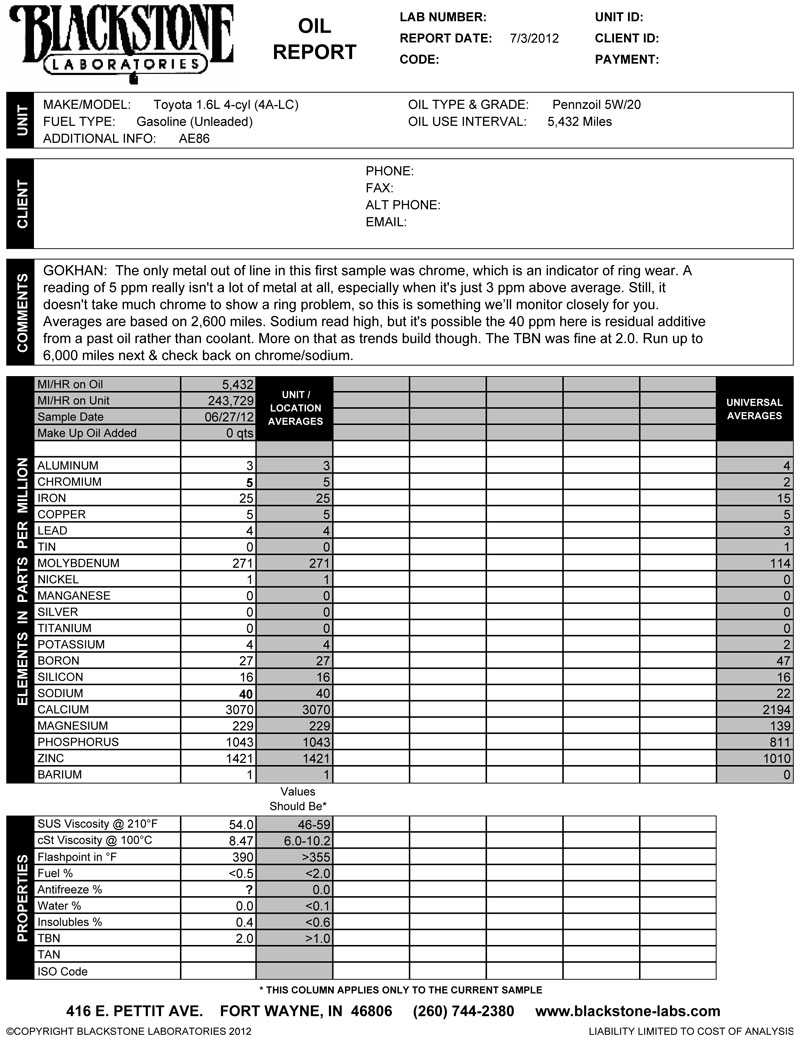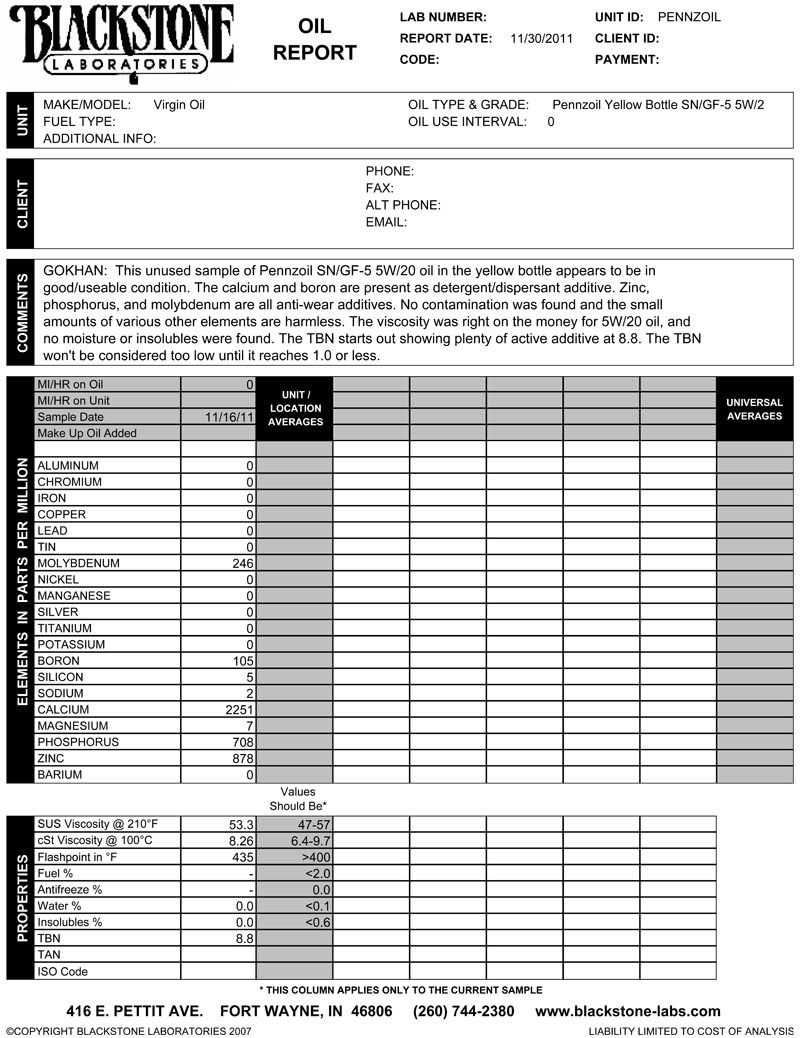I just got this UOA results. Pennzoil yellow bottle conventional 5W-20 SN/GF-5, 5,432 miles / 7.4 months on the oil, 243,729 miles on the 85 Toyota Corolla 4A-LC engine (AE82, not AE86). OEM oil filter (90915-YZZF2) and air filter and pretty much OEM everything.
Engine doesn't use any oil, except I lost about a half quart during the OCI mostly due to a small leak at the oil-pan seal. No makeup oil was added.
Wear numbers are not too good, although not too bad looking at the universal averages, which are for less than half the OCI I went for.
TBN was down to 2.0, not too bad but signaling the end of life for the oil.
Previous oil was Mobil Delvac 1300 Super 15W-40 CJ-4/SM.
The new fill is Toyota Genuine Motor Oil 0W-20 SN/GF-5 (made in USA by ExxonMobil). I got if for $5.50 a quart at my local dealer, after some good negotiation. It seems to be a pure Group IV / Group V oil (no Group III) from its nauseating odor. In contrast Mobil 1 0W-20 has a much milder odor of the same kind, probably indicating less Group IV or V and more Group III in it.
Now the question is are the wear metals because of switching to a lighter grade or is it leftover from the previous oil? Or did the thinner oil clean up the sludge and varnish of the thick HDEO so well that the stuff I am seeing came from the old deposits?
By the way, I am very pleased with the Toyota 0W-20: Engine runs very smoothly and I see a noticeable decrease in friction and increase in engine horsepower in comparison to Pennzoil yellow bottle 5W-20. I really didn't like the PYB 5W-20. It felt like it resulted in too much friction and the oil degraded quickly. Synthetics do make a difference, at least in fuel economy and horsepower.
I will go with the Toyota 0W-20 with this OCI, considering how great the engine runs with it. Probably never switching back to dino oil again in the future, given how much better the engine runs with the synthetic.
Should I worry about the viscosity being too thin and consider switching to Mobil 1 0W-40 SN? Note that PYB end of life viscosity was not much lower than that of a 5W-30 (9.30 cSt minimum), probably due to some mix of the 15W-40 from the previous OCI.

I had also a VOA with this oil. Here it is for comparison. I wonder where the boron went. Note that the additives are higher in the UOA because of the leftover from the previous oil (Delvac 15W-40 HDEO).

Comments are welcome; so, please discuss.
Engine doesn't use any oil, except I lost about a half quart during the OCI mostly due to a small leak at the oil-pan seal. No makeup oil was added.
Wear numbers are not too good, although not too bad looking at the universal averages, which are for less than half the OCI I went for.
TBN was down to 2.0, not too bad but signaling the end of life for the oil.
Previous oil was Mobil Delvac 1300 Super 15W-40 CJ-4/SM.
The new fill is Toyota Genuine Motor Oil 0W-20 SN/GF-5 (made in USA by ExxonMobil). I got if for $5.50 a quart at my local dealer, after some good negotiation. It seems to be a pure Group IV / Group V oil (no Group III) from its nauseating odor. In contrast Mobil 1 0W-20 has a much milder odor of the same kind, probably indicating less Group IV or V and more Group III in it.
Now the question is are the wear metals because of switching to a lighter grade or is it leftover from the previous oil? Or did the thinner oil clean up the sludge and varnish of the thick HDEO so well that the stuff I am seeing came from the old deposits?
By the way, I am very pleased with the Toyota 0W-20: Engine runs very smoothly and I see a noticeable decrease in friction and increase in engine horsepower in comparison to Pennzoil yellow bottle 5W-20. I really didn't like the PYB 5W-20. It felt like it resulted in too much friction and the oil degraded quickly. Synthetics do make a difference, at least in fuel economy and horsepower.
I will go with the Toyota 0W-20 with this OCI, considering how great the engine runs with it. Probably never switching back to dino oil again in the future, given how much better the engine runs with the synthetic.
Should I worry about the viscosity being too thin and consider switching to Mobil 1 0W-40 SN? Note that PYB end of life viscosity was not much lower than that of a 5W-30 (9.30 cSt minimum), probably due to some mix of the 15W-40 from the previous OCI.

I had also a VOA with this oil. Here it is for comparison. I wonder where the boron went. Note that the additives are higher in the UOA because of the leftover from the previous oil (Delvac 15W-40 HDEO).

Comments are welcome; so, please discuss.


